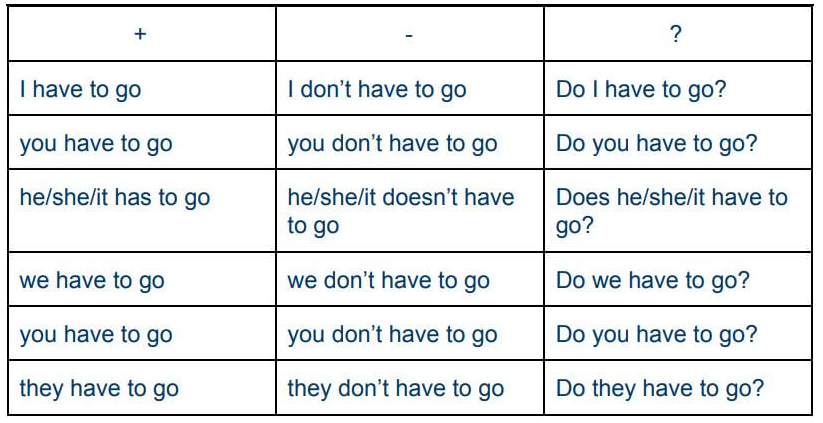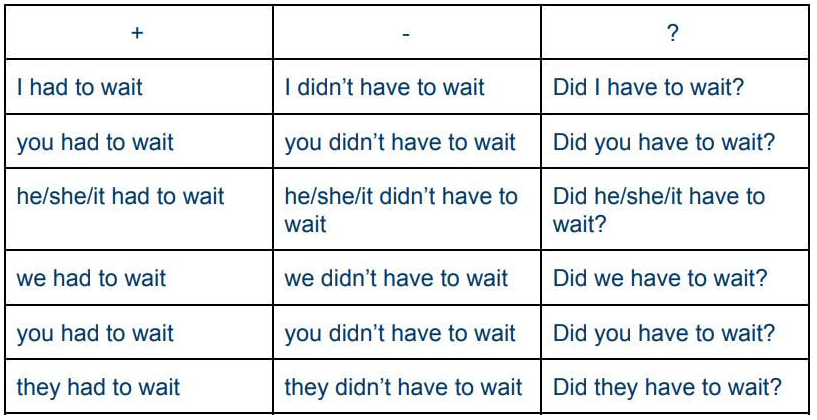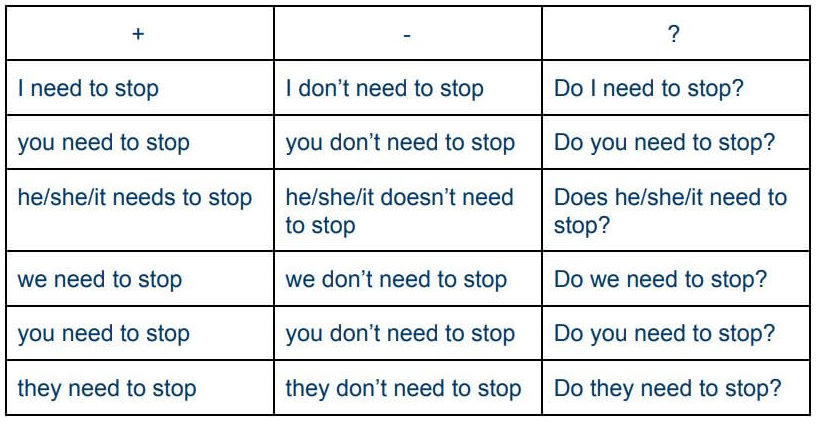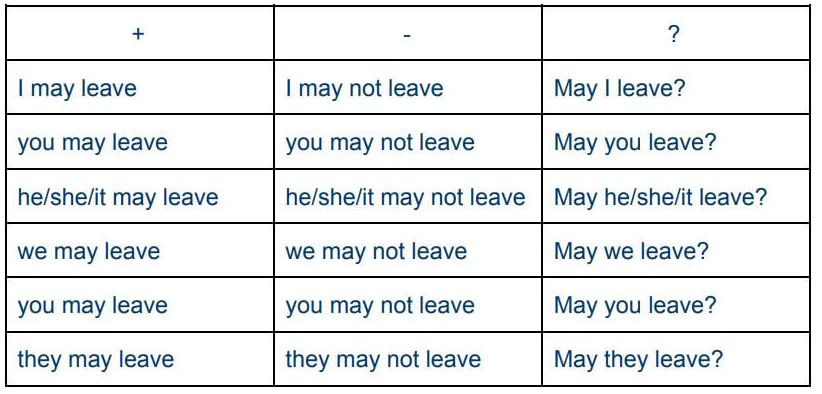The Difference Between ‘Must’, ‘Have to’, ‘Shall’, ‘Need’ and ‘May’
In English there are various ways to describe rules and obligations, and as a student it can be tricky to understand which way is right for each situation. Here is a description of each modal verb that we use to express obligation and how and when to use them.
Must
‘Must’ is the basic and most direct way of saying something is compulsory. It means you have no choice but to do (or not do) an action. We can only use ‘must’ in the present form to describe a general or permanent obligation, or an obligation in the near future. The structure of ‘must’ is easy because it is the same for every subject:

Here are some examples:
When you drive you must wear a seatbelt.
They must hand in their projects before the 8th June.
I must remember to send a birthday card to my Dad.
He must study harder if he wants to pass the exam.
We must get to the airport two hours before the flight.
To make negative sentences we add ‘not which is normally contracted to n’t:

We use ‘mustn’t’ to express a prohibition or strong obligation. For example:
When the traffic lights are red you mustn’t go.
They mustn’t use their mobile phones during lessons.
We mustn’t stand up while the plane is taking off.
I mustn’t drink any more coffee, otherwise I won’t sleep tonight.
She mustn’t go outside without a jacket. It’s really cold.
Passengers must not lean on the doors.
It’s possible to make questions with ‘must’ but it’s not very common in modern English. To make the question form we invert the subject and ‘must’:

Here are some examples:
Must I go to the party? I don’t really want to.
What time must we leave? Not later than 2pm.
Must he make so much noise? It’s really annoying.
Why must the children do so much homework?
What must you wear at work?
Who must we call for an appointment?
Have to
In the affirmative form, ‘have to’ has the same meaning as ‘must’ and is used to express obligations. However, ‘have to’ is much more flexible than ‘must’ because we can use it in the past, the present and the future. For this reason it is very commonly used in modern English. Its structure is the same as any normal verb:

Here are some examples of affirmative sentences:
I have to email the supplier before he sends the goods.
We have to do the shopping because the cupboards are empty.
She has to take two trains and a bus to get to work every day.
You have to practice if you want to be fluent.
Motorcyclists have to wear a helmet.
If you’re a foreigner you have to fill in a landing card.
We use questions with ‘have to’ to ask if something is obligatory, and questions with ‘have to’ are much more common in modern English than questions with ‘must’. Here are some examples:
What time do you have to start work?
Do we have to take anything with us to the course?
Why do they have to do overtime? – Because their deadline is tomorrow.
Does he have to wear a suit to work?
Do I have to bring some form of ID?
What do we have to do now?
The negative form of ‘have to’ has a very different meaning from ‘mustn’t’. We use ‘don’t have to’ to mean something is not necessary and that there is no obligation. For example:
When you ride a bicycle you don’t have to wear a helmet, but it’s a good idea.
She doesn’t have to come to the meeting if she doesn’t want to.
We don’t have to wear uniforms to school in Italy.
I don’t have to work on Saturdays so I can do what I want.
They don’t have to read all the books the teacher recommended, just one of them.
You don’t have to pay to use the motorways in England. They are free.
Obligations in the past and in the future
To describe an obligation in the past, the only form possible is the past of ‘have to’ which is ‘had to’. So the simple past form of ‘must’ is ‘had to’. The structure is the same for all subjects:

For example:
I had to wait a long time for my bus.
We didn’t have to use our passports. They accepted our ID cards.
Did you have to pay a fine when the police stopped you?
The doctor told her she had to lose weight.
They had to queue up for two hours to get through security. They almost missed their flight.
You had to do a lot of conference calls in your last job, didn’t you?
We can also use ‘have to’ in other tenses, like the present perfect form when we want to describe recent obligations or obligations within an unfinished time period. For example:
I’ve had to work a lot this week.
She’s had to leave early because her daughter is sick.
They haven’t had to go to the doctor for years. They’ve very healthy kids.
We can also use ‘have to’ with ‘will’ to describe an obligation, or lack of obligation, in the future. For example::
You’ll have to work hard if you want to get a promotion.
We’ll have to hurry up. The film starts in ten minutes.
She won’t have to start her job until next month, so she’s going on holiday.
Will they have to sign a register during lessons?
I’ll have to train hard for the marathon. I’m not fit enough yet.
You’ll have to tell Marie the truth, otherwise you’ll get into trouble.
Must or Have to?
So when do you use ‘must’ and when do you use ‘have to’? Generally speaking, in the present affirmative form you can use either ‘must’ or ‘have to’. However, there is a slight difference when we speak in the first person. When you want to describe an internal obligation (an order you give yourself), it’s better to use ‘must’. For example:
These pants don’t fit me anymore. I must lose weight.
On the contrary, when you describe an external obligation (an order someone gives you) we use ‘have to’. For example:
My doctor told me I’m overweight and I have to go on a diet.
Instead when orders are general and official, for example on notices and documents, we usually use ‘must’. For example:
Passengers must keep their bags with them at all times.
In negative sentences you need to remember that if you want to describe an obligation to not do something, you need to use ‘mustn’t’. While if you want to say that there is no obligation, use ‘don’t have to’. For example:
You mustn’t do that! (Don’t do it because it is not permitted.)
You don’t have to do that. (You have no obligation to do it but you can if you want to.)
Shall
In some documents and official situations you can find ‘shall’ used to describe formal obligations. For example:
Employees shall provide a medical certificate for sick leave.
Both parties shall give reasonable notice if they cannot attend the hearing.
Hotel guests shall pay for any damage to the rooms.
Members shall not use the gym equipment without a demonstration from the staff.
You shall wear your ID badge at all times.
Applicants shall come to interviews with their CV and copies of their qualifications.
Need
We use ‘need’ to describe a necessity. It has a very similar meaning to obligation and can therefore be a more polite way of saying ‘must’ or ‘have to’. Unusually, ‘need’ is both a normal verb and also a modal verb. In almost all cases you can simply use the normal verb form which has a regular structure:

Here are some examples:
We need to fill up with petrol. The tank is almost empty.
Do you need anything from the shops?
They don’t need to come early. They can come whenever they’re ready.
In modern English, ‘need’ as a modal verb is only really used in the negative form and without ‘to’. For example:
You needn’t do the washing up. I’ll do it later.
They needn’t complete the work right away. There’s plenty of time.
She needn’t worry about going to the dentist’s. He’s very kind.
N.B. You ‘don’t need to’ and ‘you needn’t’ are very similar in meaning to ‘you don’t have to’.
May
We use ‘may’ to ask and give permission formally. The structure of ‘may’ is like any other modal verb:

Here are some examples:
May I come in?
You may have a seat here. The officer will come in a few minutes.
They may use the equipment as long as they use if carefully.
May we have some water?
He may take the exam again.
You may not use your phone while driving.
So now you’ve seen the differences these ways of expressing obligation, you’re ready to practice! Try some fun exercises and do extra practice by making some examples to describe some of your personal obligations.
Of all the English verbs, the most important two are ‘to be’ and ‘to have’. Learn how to use them in this article.
The Past Perfect tense enables you to compare different times and actions in the past.